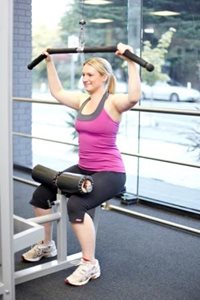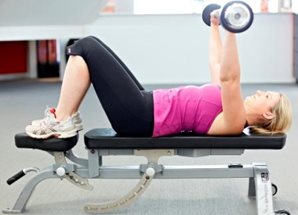Exercising with weights

Now that you have had your baby or babies, you will be keen to get back into shape! However if your pelvic floor muscles don’t quite feel right yet, but you want to start with some weights, a great tip is to sit down on a Swiss ball to exercise and start with light weights.
The 10 step guide to pelvic floor safe exercises was developed during the Pelvic Floor First campaign. These were designed using Michelle Kenway, Pelvic Floor Physiotherapist's methods for helping women to be able to safely exercise while protecting their pelvic floor. Whilst her focus is on women with a prolapse and older women, these are great principles to use post natally.
They can be found on the Pelvic Floor First website, where there are many tips on exercising safely while protecting your pelvic floor muscles and preventing problems from developing, which is our focus. Read more about our Post natal Exercise Guidelines to help you safely return to sport and exercise whilst you protect those vulnerable areas of your body.
Whilst doing weights in a lying or sitting position, it is also important to not hold your breath. So if the weight is too heavy for you to push or lift easily without holding your breath, then it means that the pressure caused inside your abdominal area (called intra abdominal pressure) is too great. This can cause pressure either downwards upon your pelvic floor, backwards potentially straining your back, or forwards onto your abdominal muscles. If any of these areas is not yet fully recovered from the effects of pregnancy, stretching and hormonal changes then lifting too heavy a weight can potentially cause a problem. If you are unsure, check your technique first without weights, or with very light weights. If your health or exercise professional can check for you, they can notice what your breathing pattern is like when you do the exercises, and also they can see whether or not there is any straining or ballooning out in your abdominal area while you exercise. This can potentially widen any abdominal muscle separation, and in the end take longer to get back fully to exercise. Steady progression and gradual increase of weights is better, than trying too hard, too soon.
 Also become aware of your fatigue level, as when you are tired, your technique can change and be less focused. That means even if you could do an exercise well last week, but you come to do it this week after interrupted sleep the night before, you may find it harder to do. Be kind to yourself and know that balancing the demands of a baby, babies, toddlers and children takes energy and attention. While we know that you can better cope with this when you are fit, there is the time to be careful, take it more slowly and keep the balance, which is way better than having an injury and being set back.
Also become aware of your fatigue level, as when you are tired, your technique can change and be less focused. That means even if you could do an exercise well last week, but you come to do it this week after interrupted sleep the night before, you may find it harder to do. Be kind to yourself and know that balancing the demands of a baby, babies, toddlers and children takes energy and attention. While we know that you can better cope with this when you are fit, there is the time to be careful, take it more slowly and keep the balance, which is way better than having an injury and being set back.
Check the weights that you use in all positions, including lunges and squats, as holding your breath with any exercise post natally should be avoided.
.jpg.aspx)
2011-2018. Copyright. Demac Resources Pty Ltd.
www.thepregnancycentre.com.au
Photos Copyright 2011-2018. Continence Foundation of Australia, used with permission.